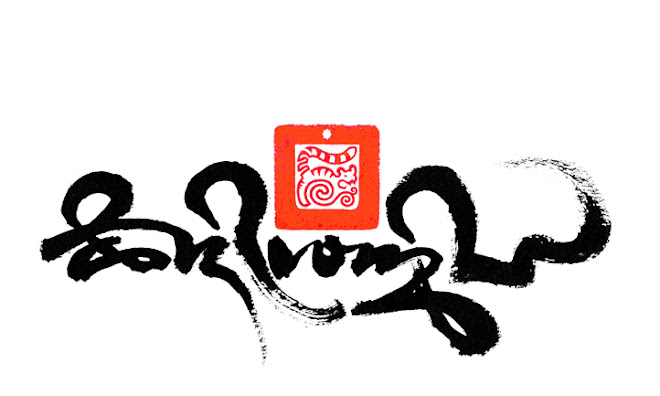 |
| The word 'impermanence' mi rtag pa in the Tibetan Drutsa script style. |
The fragile nature of flowers and paper.

Photographs and calligraphy Tashi Mannox, 4th May 2009.

'The Beauty of Change'

The word 'transformation' in the Drutsa script.

'Opportunity'
The Tibetan Drutsa calligraphy in this piece translates as ‘to seize the moment.’ These words depicted entangled with the stems and leaves of five different coloured lotus flowers. Each of these flowers represents the five wisdoms of the five Buddha families. Even the leaves themselves are hooked to grab as opportunists.

“Impermanence”
Nothing ever stays the same!
The words ‘mi rtag pa’ meaning 'impermanence' in the toppling Tibetan Tsugring script, are made up of small dancing skeletons, this figures fade into decay at the base of the letters. The personal seal of the artist is also broken into two.
Calligraphy artist Tashi Mannox. all images shown and not stated otherwise are created by the artist and the photographer. please respect the copyright. Thank you.

"Impermanence" attracted me as soon as I first glimpsed upon this work of yours. The almost tumbling array of syllables, the broken seal and above all the unique texture of the strokes themselves.
ReplyDeleteIt seems to present something very serious and grave (as is the motif of skeletons) with a smile, in movement, almost like a dance. Then, of course, nothing stays the same. As soon as the artist put up these letters, they begin to fall apart. Lovely.
I would like to ask you a question about the calligraphy for "transformation."
ReplyDelete(I am new to Tibetan scripts so please forgive my mistakes.)
There are what seem to be two separators so I interpreted this to mean that there are three syllables.
The third syllable appears to correspond to "pa" and I will be brave and say that the second corresponds to "gyur."
It is the first syllable that I am struggling with. I see the consonants for "ya" and "sa" but am unable to go any further.
In one dictionary I have seen the phrase "yongs su gyur pa" and I am curious as to whether this is related to the phrase that you used.
If you can help me understand this better I would be very grateful!
The words i used in "transformation" calligraphy mean more than just "yongs su gyur pa", i used a different variation of the meaning:
ReplyDeleteThis is made up of two elements to the word, the first part of the calligraphy reads sprul སྤྲུལ་ which has the meaning to incarnate, emanate, miraculous transformation. the second is bsgyur བསྒྱུར་ which means to change, transform.
Both together translate as '(to display) transformation' such as a 'tulku', incarnate Lama: sprul sku apparitional body.
I hope that helps.
Tashi